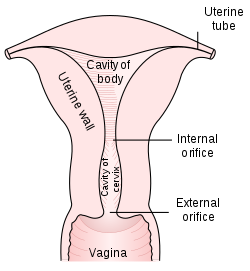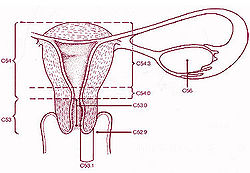External orifice of the uterus
| Cervical canal | |
|---|---|

|
|
 |
|
| Details | |
| Identifiers | |
| Latin | canalis cervicis uteri |
| Dorlands /Elsevier |
c_04/12208566 |
| TA | A09.1.03.018 |
| FMA | 17740 |
|
Anatomical terminology
[]
|
|
In the anatomy of the female reproductive system, the cervical canal (also called the canal of the cervix, endocervical canal, cervical canal of uterus, or the cavity of cervix) is the spindle-shaped, flattened canal of the cervix, the neck of the uterus.
It communicates with the uterine cavity via the internal orifice of the uterus (or internal os), and with the vagina via the external orifice of the uterus (ostium of uterus or external os). The internal orifice of the uterus is an interior narrowing of the uterine cavity. It corresponds to a slight constriction known as the isthmus that can be seen on the surface of the uterus about midway between the apex and base. The external orifice of the uterus is a small, depressed, somewhat circular opening on the rounded extremity of the cervix, opening to the vagina. Through this aperture, the cervical cavity communicates with that of the vagina.
The external orifice is bounded by two lips, an anterior and a posterior. The anterior is shorter and thicker, though it projects lower than the posterior because of the slope of the cervix. Normally, both lips are in contact with the posterior vaginal wall. Prior to pregnancy the external orifice has a rounded shape when viewed through the vaginal canal (as through a speculum). Following parturition, the orifice takes on an appearance more like a transverse slit or is "H-shaped".
The wall of the canal presents an anterior and a posterior longitudinal ridge, from each of which proceed a number of small oblique columns, the palmate folds, giving the appearance of branches from the stem of a tree; to this arrangement the name arbor vitae uteri is applied.
The folds on the two walls are not exactly opposed, but fit between one another so as to close the cervical canal.
The endocervical mucosa is a site from which adenocarcinoma can arise. Endocervical adenocarcinoma, like cervical cancer (squamous cell carcinoma), often arises in the milieu of human papilloma virus infection.
...
Wikipedia
